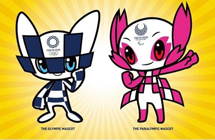东京奥运会吉祥物公布 由小学生投票选出
|
2月28日,2020年东京奥运会和残奥会吉祥物评选结果正式出炉,东京奥组委对外公布了结果,两个配有奥运会会徽的可爱机器人最终胜出。 One has an athletic figure and a strong sense of justice. The other is a cherry blossom-inspired superhero. Meet the new Olympic and Paralympic mascots that the Tokyo 2020 organisers hope will whip up enthusiasm for the Games – and drive merchandise sales.
All up, 2,042 individuals and groups submitted designs that they hoped would capture the public’s affection. Experts whittled the list down to three design pairs, which were then opened up for voting by millions of school students across Japan. 入选的三组作品,分别是配有奥运会会徽图案的机器人(A),被视为神明使者的狐狸和石狮子(B),以及经常出现在日本民间故事里的狐狸和狸子(C)。 Nearly 600 cheering schoolchildren attended a ceremony in Tokyo’s Shinagawa ward on Wednesday to hear the results of that vote. The winning Olympic and Paralympic mascots have not yet been given names, but they are said to “respect each other” and are “very good friends”. 据官方解释,奥运会吉祥物有着运动健将的体魄和公平公正的态度: “能够温故知新、将传统和近未来合而为一的角色。既珍视传统又时刻把握最新信息。正义感爆棚,运动神经超群,在任何地点都能瞬间移动。诞生自传统的市松纹和近未来的世界观。” With a futuristic blue and white chequered pattern, the Olympic mascot is described as having a special power allowing it to move anywhere instantaneously. “The mascot has a strong sense of justice and is very athletic,” the biographical notes said. 残奥会吉祥物受到樱花启发而创作: “拥有樱花触角和超能力的超酷角色。平时很文静,紧要关头能量爆棚。信念坚定,热爱大自然,能跟石头和风对话,用眼睛移动物体。” The Paralympic mascot features a pink and white design inspired by cherry blossom flowers, and it can apparently move things just by looking at them. “It has a dignified inner strength and a kind heart that loves nature,” according to the description. The winning designer, Ryo Taniguchi, is an illustrator from Fukuoka in southern Japan. “I’m just so spaced out at the moment,” he said when the decision was announced. “I just want to tell my beloved wife that I’ve been chosen.” The selection of mascots had attracted wide publicity across Japan. Some 200,000 classes at 16,000 schools took part in selection process. Mascots are big business in Japan, with many towns and companies trying to come up with distinctive design to promote their region or product. Staffers wearing big cuddly costumes often turn up at trade and food festivals to meet and greet visitors – and hand out business cards. The best-known mascots can drive sales. Sales of food and toy products bearing the image of Kumamon, ubiquitous black bear from Kumamoto region, hit a record 128 billion yen in 2016. The organisers presumably hope that the mascots will have a more successful reception than original Tokyo 2020 logo unveiled in 2015. The design had to be replaced after accusations of plagiarism. |









